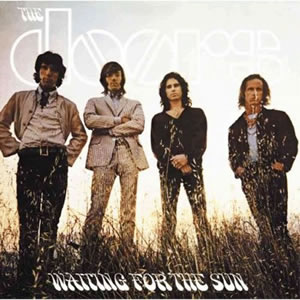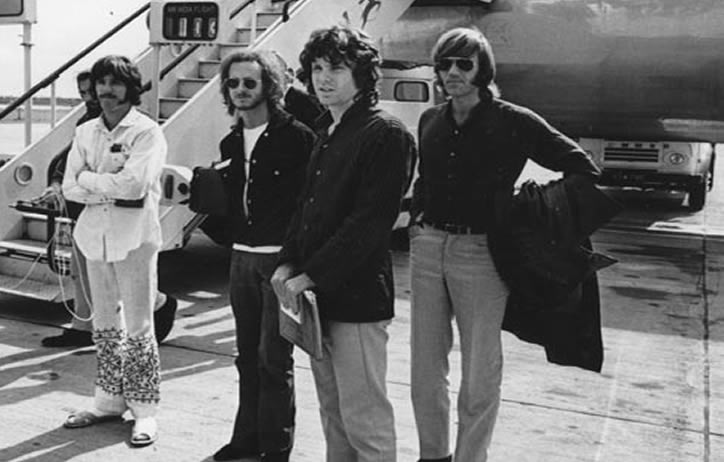Waiting For the Sun by The Doors
 The Doors third album, Waiting For the Sun, is probably the weakest of their six original studio albums. Lead vocalist and lyricist Jim Morrison admitted that he was not the top of his game in 1968, being less of a prolific reader and writer in 1968 after the group’s rise to rock stardom the previous year. All that being said, this album still contains some brilliant moments during its short thirty-three minute duration, including some which help define the group’s strong legacy. Released in July 1968 when the group was (arguably) at the height of their sixties popularity, Waiting for the Sun the band’s first and only number one album in the US and their initial breakthrough album in the UK.
The Doors third album, Waiting For the Sun, is probably the weakest of their six original studio albums. Lead vocalist and lyricist Jim Morrison admitted that he was not the top of his game in 1968, being less of a prolific reader and writer in 1968 after the group’s rise to rock stardom the previous year. All that being said, this album still contains some brilliant moments during its short thirty-three minute duration, including some which help define the group’s strong legacy. Released in July 1968 when the group was (arguably) at the height of their sixties popularity, Waiting for the Sun the band’s first and only number one album in the US and their initial breakthrough album in the UK.
Departing from The Doors’ first two albums, which were similar in structure and dark mood and contained strong extended pieces to finish up the album, Waiting For the Sun contains a lighter sound on several tracks. This is a bit ironic because the original plans for this album included the side-long epic track “Celebration of the Lizard”, which was composed as a series of poems by Morrison over improvised music in sections, along with other more structured “sub songs”. However, producer Paul Rothchild and the other band members rejected all but a small part of the original studio piece. Still, the lyrics for the piece were published inside the gatefold jacket of the original vinyl LP. The band did perform “Celebration of the Lizard” in its entirety live and an advanced version of the piece appeared on the band’s 1970 album, Absolutely Live.
Also omitted from the album was it’s title track “Waiting for the Sun”, as the band felt it was unfinished. This track would later be included on the 1970 studio album Morrison Hotel. This song was one where keyboardist Ray Manzarek displayed his distorted new organ sound, as he transitioned from the Vox Continental used on the band’s earliest material.
 Waiting For the Sun by The Doors |
|
|---|---|
| Released: July 11, 1968 (Elektra) Produced by: Paul Rothchild Recorded: Los Angeles, February-May, 1968 |
|
| Side One | Side Two |
| Hello, I Love You Love Street Not to Touch the Earth Summer’s Almost Gone Wintertime Love The Unknown Soldier |
Spanish Caravan My Wild Love We Could Be So Good Together Yes, The River Knows Five To One |
| Band Musicians | |
| Jim Morrison – Lead Vocals, Percussion Robbie Krieger – Guitars, Vocals Ray Manzarak – Piano, Organ, Vocals John Densmore – Drums, Percussion, Vocals |
|
With the omission of certain planned tracks, The Doors had to dip back into their archives for material. “Hello, I Love You” was one of Morrison’s earliest compositions, dating back to 1965. The infinite buzz by guitarist Robbie Krieger and the groovy sixties sound, brought the band from the edge of darkness to the center of pop with this number one song, which sold over a million copies in the U.S. alone. However, this light song was not without controversy, as several critics pointed out the main vocal melody is dangerously similar to The Kinks’ “All Day and All of the Night”. Further, Morrison grew to loathe this song to the point where Manzarak was forced to frequently sing lead vocals when it was performed live.
Through the rest of album the songs vacillate wildly. “Love Street” is a deceptively clever ballad, which starts sounding like an airy show tune but contains some hardcore rock elements underneath. This Baroque pop song with fine piano and organ originated as a poem by Morrison about the street he lived on in Laurel Canyon, CA with his girlfriend Pamela Courson. The most pointed lyric came from watching local hippies walking by to visit the corner store across the street from their residence;
I see you live on Love Street, there’s the store where the creatures meet. I wonder what they do in there?”
The only section of “Celebration of the Lizard” to make it on the album, “Not to Touch the Earth” is almost out of a dramatic movie scene. The bass line and overall rhythm continuously gets more intense, mirroring Morrison’s vocals. The opening lyrics come directly from subchapters in The Golden Bough by James Frazer with the rest being opaque poetry which is open to interpretation. Drummer John Densmore offers timely fills and a tight beat to hold the thrilling chaos all together.
“Summer’s Almost Gone” is another tune re-born from the group’s earliest days. The descending bass/keyboard riff reminds one of much of the repetitive material from Strange Days, albeit with some underlying honky-tonk piano by Manzarek and bottle-neck slide guitar by Krieger for variety. “Wintertime Love” goes in the opposite direction (both musically and seasonally). This short and upbeat European waltz is good composition with melodic vocals by Morrison and great bass by session man Douglas Lubahn, who provided bass for much of the album.
“The Unknown Soldier” is an intentionally controversial song, examining the Vietnam War and how it was viewed on television back in the United States. Complete with mysterious and eerie organ sounds in the verses and a literal march towards execution in the middle of the song, the Doors produced one of the most unusual and complex tracks of their career. The song then erupts into a climactic and celebratory coda, which envisions a victorious end of war. While the single and its promotional video were banned from much mainstream media, the song still managed to find its way into the Top 40.
Side two of Waiting For the Sun begins with “Spanish Caravan”, highlighted by some fantastic flamenco guitar by Krieger through the first verse and chorus, one of the most accomplished musical sequences in the Doors collection. The eventual turn electric is like a preview of the later genre of progressive rock, making this short piece an overall forgotten classic. Contrarily, “My Wild Love” may be the worst Doors song ever. A Morrison-inspired group chant, this unfortunate experiment should have been shelved for some later rarities collections. “We Can Be So Good Together” is upbeat and fun and sounds like it could have been every bit as successful as “Hello, I Love You” commercially. The song was recorded during the sessions for Strange Days and even appeared on an early track listings for that album.

“Yes, The River Knows” is a beautiful, poetic love ballad with moody piano, in the same vein as “The Crystal Ship” from their debut. The superb picked electric guitar phrases by Krieger, accompanied by Manzarak’s classical piano and Morrison at his most melodic, really show the range of the Doors musically. The album closer “Five to One” is a thumping anthem which marks its place in time while leaving more questions than it answers (Is it a love song? Sex song? Song about murder? Revolution? Social commentary?). Part of the song (“Your ballroom days are over baby/Night is drawing near/Shadows of the evening/crawl across the years”), was seemingly lifted from the 19th-century hymnal and bedtime rhyme “Now the Day is Over”, while some say Morrison was possibly referring to a Dylan Thomas story in another part of the song. In any case, this proto-heavy metal track is an ode to brute force and a Doors classic.
To date, Waiting For the Sun has sold over 7 million copies worldwide, a phenomenal blockbuster for most groups. While the album was critically panned upon its release, the stronger parts of the record held up well over time, especially for those who enjoy the band’s diversity.
~
Part of Classic Rock Review’s celebration of 1968 albums.




